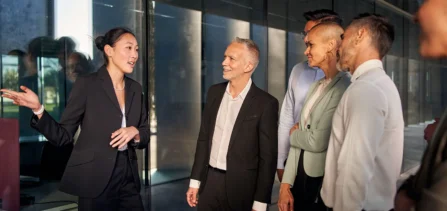
The Proven Principles Of Effective Workplace Communication
Effective workplace communication is the foundation of meaningful relationships and successful outcomes, both personally and professionally.
Effective workplace communication is the foundation of meaningful relationships and successful outcomes, both personally and professionally. When done well, it fosters understanding, resolves conflicts, motivates change, boosts employee engagement, and transmits critical information clearly. Mastering a few core principles can significantly enhance one’s communication skills.
This guide looks at key elements that help improve communication in the workplace. It begins by highlighting important principles for both speaking and writing: being clear, listening actively, and showing empathy. These skills help build understanding between people.
The guide then offers practical strategies for use in professional environments, personal relationships, and for overcoming communication barriers. Remember, communication is a skill that you can always improve. This guide also includes ways to assess your own skills and tips for adapting to new situations as you continue to learn.
By using a few simple but effective principles, you can greatly improve how you communicate and connect with others. Clear, friendly, and brief messages lead to better results in business, friendships, and everyday life. Impact Factory can help you enhance your communication skills, but first, let’s look at the key principles.
Core Principles of Effective Workplace Communication
Good communication at work involves using important tools effectively. Listening actively, showing empathy, and being clear help build trust and good relationships. When you respond to others’ concerns with empathy, it helps everyone understand each other better and reduces defensiveness.
Clarity and Conciseness
Clear language leads to clear messaging and helps avoid misunderstandings. Defining terms or acronyms makes complex ideas easier for everyone to understand. Use familiar examples to clarify concepts. For instance, comparing artificial intelligence to helpful chatbots or human resources to workforce coordinators can help clarify these ideas.
Use clear language and include only necessary details. Good communicators keep extra comments to a minimum while highlighting key points by repeating them. You will remember messages better when they are communicated clearly and concisely.
To share important statistics clearly, focus on the most relevant data in large datasets without losing their meaning. Highlight key people who influence decision-makers and raise concerns for insurance policyholders. Avoid using unnecessary charts that can confuse the audience with unimportant facts, as this distracts from the main point.
When working with different teams, like legal, financial, and technical groups on large projects, clear communication is crucial. It helps prevent misunderstandings that can disrupt operations. Make sure everyone uses the same terms so that everyone’s roles, responsibilities, and goals are aligned before starting the project. Don’t just assume everyone has the same understanding.
See What We Can Do For You
If you like what you’ve seen and would like to know more please contact our team.
Active Listening
Communication is a two-way process. To really listen to someone, you need to focus fully on them without letting distractions or interruptions get in the way. Don’t think about what you want to say next while the other person is talking; let them finish without interrupting. Ensure you understand their perspective before responding. Your body language matters too.
Clarify interpretations to confirm or correct assumptions. Ask:
“So in summary, you are suggesting… Is my understanding accurate?”
Ensure that people feel assured their opinions have been genuinely acknowledged before offering any advice. This approach fosters a culture of openness and trust.
If emotions run high, calm the situation by thanking speakers for being honest. Pausing heated discussions until everyone cools down can help save strained conversations and prevent lasting damage.
Empathy and Understanding
Empathy means understanding how someone else feels. It involves imagining what the world looks like to them based on their experiences and beliefs before judging their actions.
Ask thoughtful questions to uncover subjects’ contexts, worries, and motivations. Simply query:
“What concerns prompted you to adopt this position?”
Such interest may surprise or move guarded communicators, yielding dialogue progress that was previously impossible.
Consciously emphasise areas of existing alignment before addressing differences.
“Firstly, we agree on X priority for our community’s betterment…”
builds connections persisting despite disagreements. This prefaces cooler-headed conflict resolution or compromise.
Showing real empathy comes from a genuine desire to understand different viewpoints. This requires being open-minded instead of steering conversations towards our own opinions. It is important to set aside our egos to better grasp the complex ideas that differ from our usual beliefs. This kind of self-expansion helps us gain wisdom and empathy at the same time.
Listen patiently when speakers share their confusing stories. At first, their narratives may not have a clear structure. By not interrupting, you will build trust and create a safe space for directors to discuss sensitive topics, such as workplace harassment. Once their stories are clearer, offer guidance on how to report issues properly. Help them understand that there are fair and thorough processes in place to protect their rights and ensure justice is upheld. This will contribute to a positive work environment.
Enhancing Communication in Various Contexts
Tailoring communication strategies for work and personal life is important because they have different rules and goals. Good communicators should adjust their approach to achieve specific results, like closing a sales deal or resolving a marital conflict. Understanding these key differences helps in making effective changes.
Professional Communication
Communication is the currency of workplace advancement. Savvy executives regularly employ resilience, active listening and public speaking strengths when negotiating with various departments, governing teams, and persuading clients. Those skills combined facilitate leadership ascent.
Before important conversations, outline core objectives and prepare support materials concisely. Schedule discussions where uninterrupted focus is possible to enable active listening and reasoned responses. Take detailed notes, then follow up in writing to confirm shared understandings.
There are a few communication situations that people often struggle with. You can ease your worries about public speaking by thoroughly rehearsing content and predicting questions. Focus presents compellingly, relaying complex concepts through simple examples. Boldly make eye contact with crowd members regularly, gauging engagement. Welcome clarifying queries to reinforce your point and improve understanding.
Before video conferences, prepare remarks and predictive Q&A to avoid losing audience engagement mid-stream when struggling for words. Script opening hooks to capture attention instantly.
Public telephone interactions project vocal energy equivalently as body language does face-to-face. Smiling and nodding translate into audible warmth and emphasis when expressing enthusiasm, assurance, or sympathy. Record calls to assess tone.
When providing negative feedback to colleagues via email regarding poor punctuality or attire, carefully strike a non-confrontational yet direct tone, with proper grammar. Proofread, ensuring language remains entirely professional despite addressing sensitive topics. Follow up in person, allowing open dialogue.
Personal and Social Communication
The workplace seamlessly blends professional and personal realms through office friendships and romantic relationships between colleagues, even when working with a remote team. Navigating resultant interpersonal dynamics sensitively enables smoother team cohesion.
Casual conversations can build affinities, revealing shared interests, humorous observations, or ambitions. These cement bonds strengthen collaboration, innovation, and supportiveness by humanising interactions. However, ensure relationships remain professional and maintain mutual trust.
While discouraging office dating can overstep boundaries, those in romantic relationships at work must maintain professionalism. Avoid public displays of affection and ensure personal issues do not affect work. Always keep personal matters separate from business, and remember that this is a professional environment.
Overcoming Communication Barriers
Poor communication regularly stems from 3 main categories: contrasting cultural frameworks, intergenerational expectations, and information overload. Behaviour deemed perfectly appropriate or unimportant in one group may constitute unimaginable vulgarity or priority in another. Mental preparation and self-awareness minimises conflict and promotes effective workplace communication, bridging diverse worlds and finding common ground.
Cultural Communication Differences:
Cultural intelligence (CQ) entails respecting and skillfully navigating cross-cultural communication barriers and differing communication styles. Recognising that countless equally “right” worldviews exist is vital for smooth international or interracial interactions. CQ demands patience, tolerance, and sensitivity.
When visiting or working abroad, research common etiquette no-go’s in local cultures (such as dietary restrictions or sleeveless attire taboos). Remember that direct eye contact for conversation or closing handshakes are unnecessary across Oceania and parts of Asia.
Recognise respectable communication divergences across cultures related to directness, intimacy, and confrontation avoidance. Americans articulate views frankly as honesty signifies respect, while Asia’s hierarchical nature discourages junior staff from publicly disagreeing with senior executives. Reserve judgements lacking deeper cultural insight as you work toward a common goal.
Intergenerational Interaction:
Technological transformations enable novel communication mediums constantly, especially challenging older demographics. Be compassionate when requesting traditionalists embrace digital tools that are rapidly advancing globally and maintain respectful communication. Provide thorough orientation gently without ridiculing hesitancy. In reverse, millennials may need to balance digital messaging with face-to-face discussions.
When youngsters relay opposing viewpoints on issues like politics or gender dynamics, avoid outright dismissal of modernising opinions. Strive to comprehend updated societal concerns, then highlight constant values aligning generations-passion for justice and family, for example. This demonstrates respect whilst contextualising divides. Thereafter, the scope for meaningful debate broadens and employee productivity only improves.
Information and Noise:
The internet brings endless flows of communication which may overwhelm without discernment. Continuously analysing sources’ credibility and relevance prevents distraction from online noise.
Before forwarding articles or discussing them in person, evaluate underlying agendas and factual accuracy carefully. Careful thought will distinguish truthful journalism from attention-grabbing propaganda. Promote discerning media consumption habits.
Summarise lengthy data reports concisely to determine pertinence before the entire absorption. Digests enable swift isolation of relevant research from decorative elaborations. Simplify noisy information flows through concision and precision.
Infinite content creation across millions of websites competes relentlessly for user attention amid information overload. Hence public weariness grows towards exaggeratedly optimistic portrayals downplaying legitimate hazards regarding controversial healthcare treatments, geopolitical analysis, or cryptocurrency volatility. Counter oversimplification with prudent balanced nuance alerting audiences regarding factual complexity and uncertainty where applicable.
Continuous Improvement and Adaptation
Aspiring communicators emulate experts through mindful observation at conferences or negotiations. Study techniques elevate messages’ impact and relationship-building effectiveness to boost your professional development. Routinely garner actionable feedback from diverse groups through quick surveys. Constant upgrading through multiple channels builds prowess steadily.
Feedback Gathering Techniques:
Frequently request input from colleagues, employees and family on communication strengths and growth areas. Questions may cover approachability, active listening aptitude or leading meetings productively. Consider anonymous feedback options which encourage uninhibited honesty and transparency. Be emotionally resilient facing constructive criticism or conflicting viewpoints on skill level.
Proactively observe executives addressing large crowds or small groups sensitively. Does their nonverbal communication create openness? How do they demonstrate empathy, align priorities, and overcome objections? Reflect deeply on important qualities exemplifying excellent communicators, then visualise steadily merging those qualities into everyday interaction.
Embracing Change Flexibly:
As technology and office practices rapidly advance, communicators must not rigidly cling to fading traditions but rather flexibly evolve alongside progressing workplace transformations with new communication tools. Video calls replacing in-person meetings, instant messages replacing desk drop-ins, or smart casual dress codes overriding formal attire constitute examples where adaptation enables smoother transitions to stay relevant.
When management introduces unfamiliar digital interfaces for information-sharing, avoid outright rejecting novelty based on ingrained reluctance to abandon familiar tools. Instead, invest focused energy in fully learning next-generation workplace systems, then provide constructive feedback identifying enhancements increasing user-friendliness for all age groups. This balances healthy scepticism with open-mindedness.
Likewise, widely circulated written reports risk declining industry readership as multi-platform infographics, videos and podcasts catering condensed content towards millennials’ digitally inclined preferences gain influence. Rather than complaining about cuts to elaborate presentations, adapt materials for maximum impact across generations. Content and medium must align with the audiences accessed; formats constantly shift.
Change is guaranteed when pursuing fulfilling dynamic careers. Resisting exhausts agents fruitlessly as unstoppable tides of transformation sweep whole professions. Individuals should thus direct efforts embracing shifts strategically early, critically even where warranted, while getting ahead of curves into key positioning.
Next Steps
Internalising a few core principles establishes strong foundations for meaningful, effective team communication, and team collaboration, in any situation – clarity of expression, active listening and empathy. Supporting skills, like concise message delivery and questioning techniques, augment abilities further.
Adherence to these principles while leveraging written and verbal communication suitable for professional settings optimises impact and leadership influence within workplaces.
For interpersonal relationships, applying principles underpinned by emotional intelligence nurtures harmony and lasting bonds. Adapting execution strategy according to life stages and environments encountered also enables sustained, positive communication.
While communication process mastery takes a while, instilling even the fundamental proficiencies transforms dialogues’ effectiveness and relationships’ trajectories significantly. Commit to continuous incremental improvement through feedback-informed self-assessment. Cement basics like active listening, then build confidence by adapting those in varied contexts.
Final Thoughts
Effective team communication is simply vital; we are social creatures through and through. Honing this critical capability rewards reapers bountifully across business success, personal fulfilment, and societal harmony for a positive work environment. Impact Factory can help you build strong communication skills to boost your employee satisfaction and get better results on a daily basis. Talk to our team today about how we can help you.
Further Reading
Want to learn more about effective workplace communication? Maybe you’re looking for some new skills to add to your team! Here are some resources that can help you get started:
Communication Skills Courses – If you’re ready to start training, our bespoke programmes are tailor-made to suit your communication needs.
Conflict Management Through Communication – Learn how you can reduce conflict in your workplace with communication tools. Putting People At The Heart Of Your Business – This podcast discusses how you can help your organisation stay ahead of the game by investing in your team.






